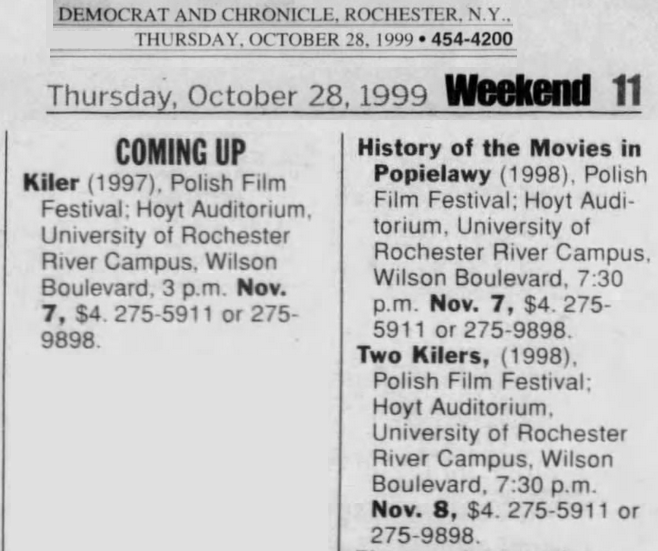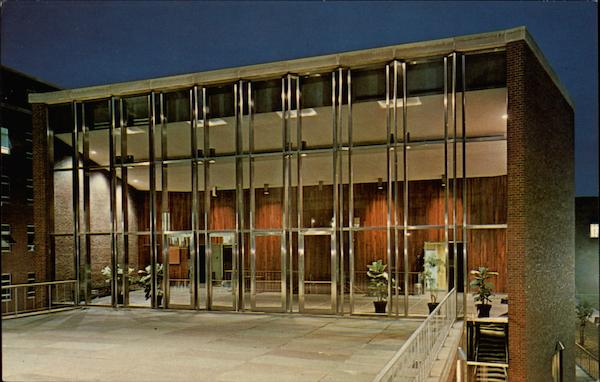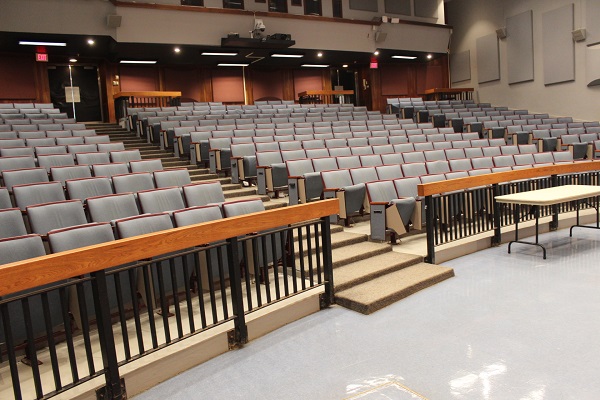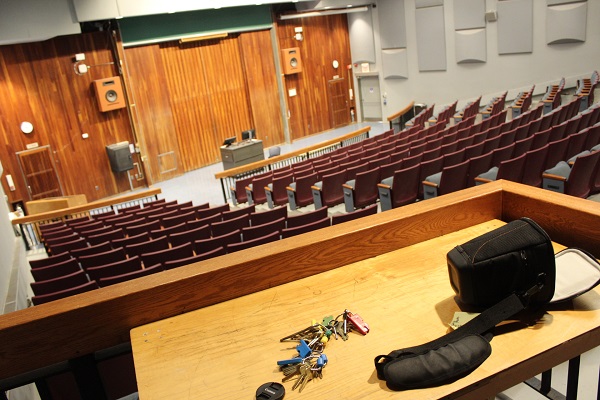The local Polish society brought in a couple of movies once each year,
and insisted on using its own projectionist, rather than the regular University of Rochester student employees.
This year, 1999, their projectionist was unavailable.
The society heard about me and wanted to talk.
So we talked.
It was Bozhena Sobolewska who spoke with me.
She was a delightful gal.

I visited the student projectionist during a show, so that he could introduce me to the setup.
His change-overs were bizarre.
He would hit a switch on the first cue, and then an automation system took over,
and the image and sound would switch simultaneously.
I asked him how to shut off that automation so that I could do it manually.
There was no way to do it. No way at all.
I explained that not all movies are cued the same way,
and that in many movies we need to change the image first, count 21 frames, and then switch the sound.
He didn’t understand, and so I explained to him about picture and sound being separated by 21 frames,
and that in some movies, both end on exactly the same frame.
So change-overs needed to be staggered for those movies.
He was confused.
Formats? Flat and Scope, of course.
Thinking that I might be able to use the primes to get larger apertures,
I asked to look at the anamorphic lenses.
He handed them to me, and I was flabbergasted.
They were not the usual anamorphic supplements screwed onto spherical primes.
They were all-in-one, and no larger than a prime.
I think they were by Schneider.
My jaw dropped to the floor.
“I’ve never seen anything like this before.
These must be good!”
The guy was totally puzzled.
What was I marveling at?
I tried to explain that these were not like any anamorphic lenses I had ever seen before,
but that just made him even more puzzled, because he had never seen any other variation.
He didn’t get it at all.
Since these were single pieces, they weren’t going to serve my purpose.
“Where are your other lenses?”
“This is it.”
“No, there have gotta be other lenses in here.
Where are things stored?”
He pointed out a massive and dusty heap of stuff off at the far end of the booth.
My memory is that it was not a neat stack, but a haphazard pile, about waist-high, or maybe chest-high.
I started digging through it, and right at the bottom, on the floor, were two unopened cardboard boxes,
postmarked 1962, from a lens company (Schneider, I think).
I cut open the boxes, and inside were two lenses of the focal length we needed for Academy 1:1.375.
They had been sitting there for 37 years, unnoticed.
I put them on, inserted my own aperture plates, and showed him what they were about.
He understood, but I didn’t get the impression that he took it seriously.
Oddly, I do not remember any of the machines there.
I do remember that the screen would roll down from the ceiling,
and that it was on a motor that could be operated from the booth.
I do remember that the machines all seemed to be circa 1962.
Century picture and sound? Strong xenon? I don’t remember.
There was some sort of 16mm pedestal projector.
How did I get the 2.78" diameter lenses into the 4" lens holders?
Were there spare collars?
Or did I just pull the other lenses out of the collars?
I remember that I brought along my own apertures, including Silent, MovieTone, Academy, and 1:1.66,
yet I do not remember purchasing or filing those apertures,
nor do I know what became of them afterwards.
What kind of rewinder?
Or did I just use my own hand rewinder and ignore the electric one?
I have no memory of any of this.
The films arrived a few days later.
Kiler,
Historia kina w Popielawach,
and
Kiler II.
They arrived on 1,000' cores, each core in a can.
Less than 1,000', actually.
The longest core was maybe eight minutes.
Fortunately, I had thought to bring along my double-flange, and so I could mount the cores onto house reels.
Brand new. Fresh from the lab. Perfect!
Yay.
The films were hard-matted in the camera at 1:1.66, and so I would just project them at 1:1.375 with black bars showing.
Better than cropping, no?
I’m glad I did that anyway, because there was a single effects shot in Historia kina w Popielawach
that was 1:1.375, a magical/mystical image of a woman dancing, and it looked better at 1:1.375.
Sometimes accidents work, you know?
As I was mounting and inspecting the prints, I could hear the class downstairs, which was miked and pumped into the booth.
It was a fascinating lecture on twin studies, the nearly identical personality of twins raised apart, which is a topic of vast importance.
What bothered me, and continues to bother me, though, about twin studies,
is that nobody seems to factor in the environmental commonality that twins raised apart share;
namely, they were raised apart! They were adopted out!
That in itself would bring about some of the identical results.
Great lecture, though.
A few days later, just before showtime, Bozhena told me how to recognize the end of the film.
It says “Koniec,” she said.
I was surprised by her pronunciation.
“I thought it was ka-NYETS. ”
She didn’t understand, but then a few moments later I realized my error.
Simultaneously, we both blurted out, “Oh! That’s Russian!”
I continued: “Конец! Oh. Sorry.
That’s what I see at the end of Russian movies: Конец.
So it’s pronounced differently in Polish. KO-nyets .”
Fascinating.
I ran the films, there was a sinking feeling in my stomach, I was almost in tears, and I was ready to scream.
Whoever programmed the automatic change-overs set the timing wrong, exactly eight seconds,
though change-overs are properly 7⅓ seconds.
For brand-new prints of most brand-new Hollywood movies, that’s okay, because the second cue is at least 24 frames prior to the final frame.
So, for a brand-new print of a typical brand-new Hollywood movie, from the first cue there are at least 8⅓ seconds to the final frame.
An 8-second delay works with brand-new prints of most brand-new Hollywood movies.
Polish movies are different.
The second cue was, I think, six or eight frames prior to the final frame.
7⅓ seconds is all you get for a Polish movie.
I bungled every last change-over and got a moment of black on screen.
There was nothing I could do about it. Nothing at all.
I was profusely apologetic.
For the final film, which would be shown the next day,
I decided to be ready. This time I brought along my grease pencil.
I added earlier cues, two-thirds of a second too soon,
so that the automation wouldn’t bungle the change-overs this time.
The movies?
Not so good, but fascinating.
Kiler could have been hilarious had it not been so overtly dumb.
Historia kina w Popielawach had a lot of promise.
It was lyrical, bucolic, wistful, lovely to look at,
but writer Jan Jakub Kolski didn’t seem to have a grasp of narrative,
nor did he seem to have a grasp of human personality,
especially the human personalities of the female of the species.
The story and the characterizations did not ring true at all, but my oh my, was some of it marvelously effective!
Kiler II was a disgrace.
Despite the problematic scripts, the actors and technicians were out of this world. Brilliant.
Text: Copyright © 2019–2021, Ranjit Sandhu.
Images: Various copyrights, but reproduction here should qualify as fair use.
If you own any of these images, please contact me.
Images: Various copyrights, but reproduction here should qualify as fair use.
If you own any of these images, please contact me.


